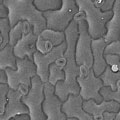The quest for more robust crops
Long sought after receptor for plant stress hormones identified
01.05.2009, Press releases
Field crops that need less water than before yet maintain their yield – that is something German farmers will soon need in light of climate change. In order to get plants to save on water, their “internal alarm system” must be rendered more sensitive. The core of this alarm system is a signal receptor – one that plant researchers worldwide have been trying to track down for years. Botanists at the TU München have now succeeded in identifying this receptor. They have published their findings in the prestigious journal “Science”.
Droughts are extremely stressful for plants. When it gets too hot or too dry, they release the stress hormone abscisic acid (ABA). Among other functions, this substance cues plants to close their stomatal apertures, the miniature pores in the surface of their leaves, and thus reduce the loss of water. However, to initiate this adaptive response, plants must first detect the presence of ABA. The precise mechanism behind this remained unknown for a long time. Numerous teams of researchers were hunting for the ABA receptor in question. Now, a team led by Prof. Erwin Grill from the Chair of Botany at the Technische Universität München (TUM) has discovered the receptor, at the same time as a group of scientists from California.
Prof. Grill and his colleagues used previously known elements in the alarm signal chain as a starting point for their research. Enzymes from the group of protein phosphatases normally act as a gate, blocking the transmission of the ABA signal into the cell. The protein phosphatases must be active for the gate is to remain closed. Under stress this activity is interrupted and the “enzyme gate” opens: the signal is forwarded and the adaptive reaction initiated. The scientists were already familiar with two protein phosphatases considered to be the most effective enzyme barriers for the ABA signal. “That is why we looked specifically for proteins that bind with these protein phosphatases, hoping to inactivate them in that way,” said Prof. Grill.
To this end the scientists mixed different proteins with protein phosphatases in vitro to produce protein complexes. They then added ABA to each of these mixtures. Four of the protein complexes showed no change, yet the fifth mixture stopped the activity of the protein phosphatases instantaneously upon the addition of ABA. Was this the sought after receptor that would allow the alarm signal be transmitted and trigger the plant to save water? The researchers needed more certainty.
So they turned to “isothermal titration calorimetry”. This elaborate chemical method of measurement can be used to determine if molecules bind to each other on the basis of small changes in temperature. The method is routinely used at the TUM Chair for Biochemistry in Garching. With the support of their biochemistry colleagues, the botanists from the Center for Food and Life Sciences Weihenstephan (WZW) were indeed able to prove the binding of ABA using the discovered protein. They then named the long sought after receptor RCAR1.
After discovering the interaction between protein phosphatases and RCAR1in the test tube, the botanists successfully verified it in living plants as well. Here it turned out that the investigated thale cress (Arabidopsis thaliana) was more sensitive to the stress hormone ABA when it was prompted to produce larger amounts of the RCAR1 protein though genetic manipulation. This means the discovered receptor RCAR1 can indeed make the internal alarm system more sensitive. And it does not seem to be the only substance: the researchers found 13 further proteins that obviously work in the same way.
“With our discovery we have made a breakthrough in understanding stress reactions in plants,” Prof. Gill was happy to report. The findings of the TUM researchers could be useful in the future development of agricultural crops that thrive on less water and have a better tolerance for periods or drought. Considering the increasing shortage of water in many parts of the world, this discovery could fulfil many a farmers dream.
Contact:
Technische Universität München
Center for Food and Life Sciences Weihenstephan (WZW)
Chair of Botany
Prof. Erwin Grill
Phone: 08161 / 71 - 5434
Fax: 08161 / 71 -5432
Email: erwin.grill@wzw.tum.de
Literature:
Ma, Y., Szostkiewicz, I., Korte, K., Moes, D., Yang, Y., Christmann, A., and Grill, E. (2009): Regulators of PP2C Phosphatase Activity Function as Abscisic Acid Sensors. Science, Published online 30 April 2009; 10.1126/science.1172408
A publication by the team of researchers from California who described the ABA receptor in parallel with and in exchange with the TUM research group will appear in the same issue of Science.
Background:
This study was funded by the Deutsche Forschungsgemeinschaft (German Research Foundation), the European Union and the Fonds der Chemischen Industrie.
Kontakt: presse@tum.de
More Information
| 090430_ABA-Rezeptoren.pdf |
Druckversion dieser Pressemitteilung,
(Type: application/pdf,
Size: 179.6 kB)
Save attachment
|
|
| 090430-ABA-receptor_en.pdf |
Print version of this press release,
(Type: application/pdf,
Size: 88.4 kB)
Save attachment
|




